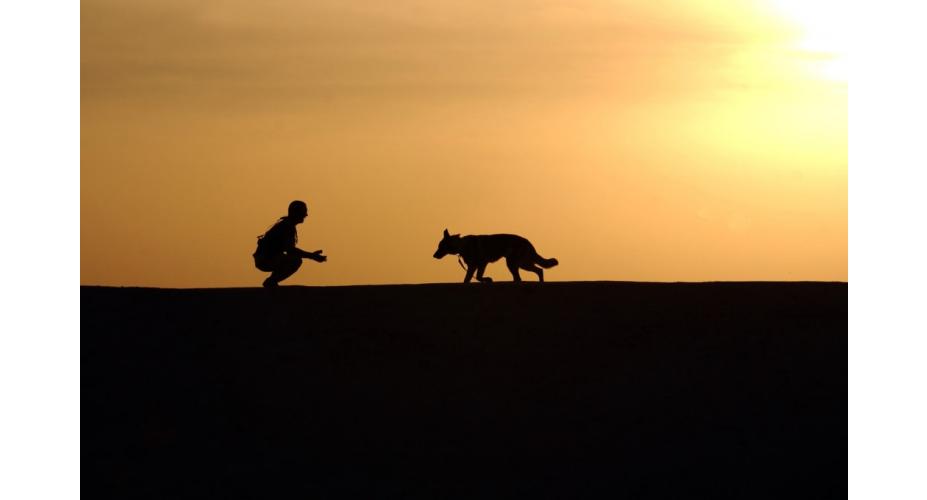
Running with your dog can be pure joy. They love getting out of the house, bonding with you, and moving. It can be an essential part of keeping them at a healthy weight—and it’s good for you, too. It’s pretty easy to send a quick text begging off your training run with your two-legged running partner, but it’s harder to ignore those puppy-dog eyes pleading to go for a romp. The trend of running with your dog has grown far beyond charitable Doggie Dash 5Ks to a bona fide sport where runners race with their dogs. But you shouldn’t just grab a leash and run out the door. Here’s what to know to get off on the right paw:
1. Check With Your Vet
It’s always a good idea to check with your physician before beginning a fitness regime—and the same holds true for your pup. Your vet will let you know if your dog is ready to start sustained running.
2. Puppies Shouldn’t Go on Long Runs Before Six Months Old
It seems counterintuitive, right? Puppies race around constantly. In fact, it can be difficult to contain their boundless energy and running can seem like a much-needed outlet to wear them out. But running around in the backyard is different than going running. As a general rule, puppies shouldn’t join you on sustained runs before they are six months old. Going running sooner can negatively affect his or her growing joints and muscles. Large and giant breeds may need to wait even longer.
3. Breeds Take to Running Differently
 Some dog breeds are born runners, while for others it could be dangerous. Andreas Wagner
Some dog breeds are born runners, while for others it could be dangerous. Andreas Wagner
Huskies? Yeah, they were born to run. Running with short-nosed dogs (aka “brachycephalic” dogs), such as pugs, boxers, and bulldogs may be too risky altogether because their airways make it harder to breathe when exerting themselves. Again, check with your vet about your particular pup’s ability to join you on runs.
4. Be Confident Your Dog has Good Leash Manners
As the adage goes, walk before you run. Practice walking with your dog next to you, rewarding him or her for doing so. You may even want to start in low-distraction areas, like the hallway in your house, before moving outside. As you two perfect walking together, increase your speed. Establishing a foundation of good manners will help prevent tripping over each other in the future—particularly when your dog inevitably sees a squirrel, kid, or hot dog stand and is tempted to make a break for it.
5. Get the Right Equipment
If you want to use a hand-held leash, check out bungee leashes. Even if your dog has good leash manners, he or she may try to dart away. The bungee will prevent them from taking you along for the ride. If you want to maintain proper running form, opt for a hands-free option. Leashes with running belts allow you to move without having to feed out or contract a leash.
Your dog might benefit from a running harness, which clips around the center of the body and the chest, rather than the neck. This will keep him or her breathing comfortably while running. Most harnesses have the added benefit of reflective trim, which helps provide visibility in low light conditions. If you’re running in snowy conditions or on hot surfaces, like sand or pavement, your pup might need from a protective layer of wax ointment on his/her feet. These balms will help insulate your pup’s paws from the elements.
6. Start Slow
You didn’t run a marathon your first time out the door, and your pooch won’t be able to either. You build distance slowly on your runs, and you’ll need to do so with your new four-legged running partner. How fast depends on the dog, but an average progression would be a half-mile every few weeks. Watch for cues that you’re progressing too fast. These include lethargy after a run, soreness, limping or difficulty getting up or lying down, refusal to go for a run, or stopping/lying down during a run.
7. Check the Terrain
 Be aware of the terrain where you run. You have shoes to protect your feet—a dog doesn’t. Patrick Hendry
Be aware of the terrain where you run. You have shoes to protect your feet—a dog doesn’t. Patrick Hendry
You’re likely running in well-cushioned shoes that protect your feet. But Rover is running barefoot. Some terrain, like grass and trails, will be kinder to their feet than asphalt or concrete. Check out running trails in your area that fit their needs, too.
8. Consider the Conditions
Dogs are much more susceptible to heat than humans. They are more prone to overheating because they aren’t able to sweat the way humans do. They primarily let off heat by panting, but that only accomplishes so much. If your pet is panting vigorously, he or she is likely too hot. Additionally, hot pavement can burn their paws. Try running early in the morning or late in the evening to avoid the heat and direct sunlight of the day. You may also need to run with water on hand for both you and your four-legged companion. On the flip side, icy winter conditions can be harmful as well. Dogs can cut their paws on ice, and chemicals and salt used to de-ice sidewalks and roads can burn their paws.
9. Listen to Your Dog
Dogs aim to please—yes, even the most stubborn ones. Their inherent drive to make you happy can push them beyond their limits. If your dog shows signs of injury, reluctance to continue, or stops flat in the middle of a run, heed those signs.
With these tips in mind, you’ll be well on your way to having a new, four-legged running buddy. Enjoy the time together!
Written by Ashley M. Biggers for Matcha in partnership with Superfeet.


